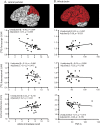Associations between tau, Aβ, and cortical thickness with cognition in Alzheimer disease
- PMID: 30626656
- PMCID: PMC6382060
- DOI: 10.1212/WNL.0000000000006875
Associations between tau, Aβ, and cortical thickness with cognition in Alzheimer disease
Abstract
Objective: To examine the cross-sectional associations between regional tau, β-amyloid (Aβ), and cortical thickness and neuropsychological function across the preclinical and clinical spectrum of Alzheimer disease (AD).
Methods: We included 106 participants from the Swedish Biomarkers for Identifying Neurodegenerative Disorders Early and Reliably (BioFINDER) study, of whom 33 had preclinical AD (Aβ-positive cognitively normal individuals), 25 had prodromal AD (Aβ-positive mild cognitive impairment), and 48 had probable AD dementia. All underwent [18F]flortaucipir (tau) and structural MRI (cortical thickness), and 88 of 106 underwent [18F]flutemetamol (Aβ) PET. Linear regression models adjusted for age, sex, and education were performed to examine associations between 7 regions of interest and 7 neuropsychological tests for all 3 imaging modalities.
Results: In preclinical AD, [18F]flortaucipir, but not [18F]flutemetamol or cortical thickness, was associated with decreased global cognition, memory, and processing speed (range standardized β = 0.35-0.52, p < 0.05 uncorrected for multiple comparisons). In the combined prodromal AD and AD dementia group, both increased [18F]flortaucipir uptake and reduced cortical thickness were associated with worse performance on a variety of neuropsychological tests (most regions of interest survived correction for multiple comparisons at p < 0.05), while increased [18F]flutemetamol uptake was specifically associated with lower scores on a delayed recall memory task (p < 0.05 uncorrected for multiple comparisons). The strongest effects for both [18F]flortaucipir and cortical thickness on cognition were found in the lateral and medial parietal cortex and lateral temporal cortex. The effect of [18F]flutemetamol on cognition was generally weaker and less region specific.
Conclusion: Our findings suggest that tau PET is more sensitive than Aβ PET and measures of cortical thickness for detecting early cognitive changes in preclinical AD. Furthermore, both [18F]flortaucipir PET and cortical thickness show strong cognitive correlates at the clinical stages of AD.
Copyright © 2019 The Author(s). Published by Wolters Kluwer Health, Inc. on behalf of the American Academy of Neurology.
Figures



References
Publication types
MeSH terms
Substances
LinkOut - more resources
Full Text Sources
Other Literature Sources
Medical
